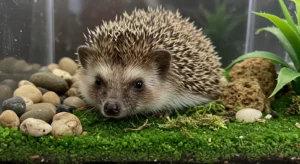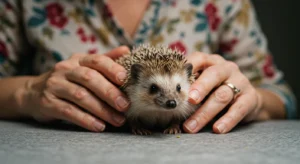Hedgehog Behavior
Hedgehog Behavior Decoded: What Their Sounds and Movements Mean
Hedgehogs may not be as expressive as dogs or cats, but they communicate their moods and intentions through a subtle combination of sounds, postures, and actions. Learning to interpret these signals is key to understanding your pet’s needs, recognizing signs of stress or contentment, and building a stronger bond. This guide breaks down common hedgehog behaviors and what they likely mean.
Hedgehog Communication: A Subtle Language
As solitary, nocturnal, prey animals, hedgehog communication often revolves around defense, exploration, and basic needs. They rely heavily on their sense of smell, but vocalizations and body language play important roles, especially in response to perceived threats or during social interactions (though pet hedgehogs are usually kept singly).
Common Vocalizations
Hedgehogs make a surprising variety of noises:
- Hissing/Huffing: The most common defensive sound. Indicates fear, annoyance, or feeling threatened. Often accompanied by raised quills and potentially curling up. A clear sign to back off or change your approach.
- Clicking/Popping: Similar to hissing, but often more intense. A stronger warning signal indicating significant fear or agitation. Usually made while balled up or preparing to ball up tightly.
- Snuffling/Snorting: Normal sounds made while exploring and sniffing their environment. Indicates curiosity and investigation.
- Screaming: A loud, high-pitched sound indicating extreme pain, terror, or distress. This warrants immediate investigation and likely a vet visit. Sometimes seen in baby hedgehogs separated from their mother or during mating disputes in adults.
- Chirping/Squeaking/Peeping: Usually heard from baby hedgehogs (hoglets) calling for their mother. Adults may make soft chirps or purr-like sounds when very content and relaxed, though this is less common.
- Coughing/Wheezing: Can indicate a respiratory infection or other illness. Requires veterinary attention.
Paying attention to the noises your hedgehog makes is an important part of monitoring hedgehog health and well-being.

Body Language & Movements
Observe your hedgehog’s posture and actions:
- Quills Flat/Relaxed: Sign of contentment, feeling safe and comfortable. May be exploring calmly or resting.
- Quills Slightly Raised (Especially Forehead): Caution, mild annoyance, uncertainty. They are aware of something and assessing the situation.
- Quills Fully Erect: Fear, defensiveness. Preparing to curl up.
- Curled in a Tight Ball: Peak defensive posture. Feeling threatened or scared. Needs space and time to relax.
- Sleeping Positions: Curled loosely, lying flat on belly (“splooting”), or on their side can all indicate relaxation and sleep.
- Jerky/Jump Startle Response: A sudden jump or flinch, often accompanied by huffing, when startled by a noise or movement. Normal defensive reflex.
- Nudging/Pushing: May nudge objects with their nose out of curiosity or try to burrow under things. Can sometimes nudge hands gently when exploring.
- Pacing/Frantic Movement: Can indicate stress, boredom, or trying to escape an uncomfortable situation (e.g., cage too small, temperature wrong, feeling threatened).
- Wobbly/Unsteady Gait: Can be a sign of illness (e.g., inner ear infection, injury, neurological issue like WHS) or attempted hibernation. Requires immediate veterinary assessment.
Understanding these postures helps in interpreting hedgehog reactions during handling.
Self-Anointing: A Curious Behavior
One of the most peculiar hedgehog behaviors is self-anointing. When encountering a new or strong smell (or taste), a hedgehog may lick or chew the source, produce frothy saliva, and then contort its body to spread the saliva onto its quills.
- Why Do They Do It? The exact reason isn’t fully understood. Theories include scent camouflage, attracting mates, transferring toxins (from chewed toads/insects) onto quills for defense, or simply as a way to intensely process a new sensory input. Self-anointing is seen in several species.
- Is it Normal? Yes, it’s perfectly normal, though bizarre-looking! Don’t interrupt them unless they are anointing with something toxic.
Context is Key
Interpreting behavior requires considering the situation:
- A huff when you first pick them up might just be initial surprise, but persistent huffing could mean they are genuinely stressed by handling.
- Snuffling during cage exploration is normal, but snuffling accompanied by lethargy could signal illness.
- A hedgehog sleeping deeply is fine, but one that is cold and unresponsive might be attempting hibernation.
Know Your Hedgehog’s Baseline: Every hedgehog has individual quirks. Pay attention to your pet’s normal behavior patterns so you can more easily recognize when something is unusual or indicates a problem.
Conclusion: Listening to Your Hedgie
By paying close attention to your hedgehog’s unique combination of sounds and movements within their specific context, you can gain valuable insights into their emotional state and physical well-being. This understanding allows you to respond appropriately, address potential stressors, seek veterinary care when needed, and ultimately build a more trusting and communicative relationship with your fascinating prickly companion.
Behavioral interpretations based on established observations from hedgehog owners, breeders, and general knowledge of animal behavior principles. Information on anointing sourced from zoological resources like Wikipedia.
















